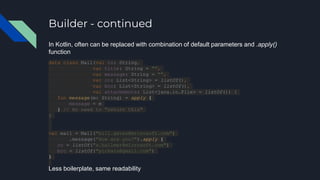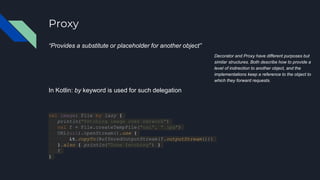Design patterns with Kotlin
- 2. Intro ● “Design Patterns” by “Gang of Four” was written back in ‘92. This is the only edition of the book. All examples in the book are either in C++ or SmallTalk ● Somebody once said that “design patterns are workarounds for shortcomings of particular language”. But he was fan of Lisp, so we can disregard that saying ● Disclaimer: all your favorite design patterns, including Singleton, will work in Kotlin as-is. Still, there are often better ways to achieve the same goal
- 3. Singleton “Ensure a class has only one instance, and provide a global point of access to it.” public final class Singleton { private static volatile Singleton instance; private Singleton() {} public static Singleton getInstance() { if (instance == null) { synchronized (Singleton.class) { if (instance == null) { instance = new Singleton(); } } } return instance; } } In Java: volatile synchronized instance static private static
- 4. Singleton - continued object Singleton Taken directly from Scala CounterSingleton.INSTANCE.increment(); When called from Java, instead of usual .getInstance() uses INSTANCE field CounterSingleton.increment() Very concise usage syntax: In Kotlin:
- 5. Builder “Allows constructing complex objects step by step” ElasticSearch API, for example, just LOVES builders... client.prepareSearch("documents") .setQuery(query(dressQuery)) .addSort(RANK_SORT) .addSort(SEARCHES_SORT) .get()
- 6. Builder - continued In Kotlin, often can be replaced with combination of default parameters and .apply() function data class Mail(val to: String, var title: String = "", var message: String = "", var cc: List<String> = listOf(), var bcc: List<String> = listOf(), val attachments: List<java.io.File> = listOf()) { fun message(m: String) = apply { message = m } // No need to "return this" } val mail = Mail("[email protected]") .message("How are you?").apply { cc = listOf("[email protected]") bcc = listOf("[email protected]") } Less boilerplate, same readability
- 7. Proxy “Provides a substitute or placeholder for another object” Decorator and Proxy have different purposes but similar structures. Both describe how to provide a level of indirection to another object, and the implementations keep a reference to the object to which they forward requests. In Kotlin: by keyword is used for such delegation val image: File by lazy { println("Fetching image over network") val f = File.createTempFile("cat", ".jpg") URL(url).openStream().use { it.copyTo(BufferedOutputStream(f.outputStream())) }.also { println("Done fetching") } f }
- 8. Iterator “Abstracts traversal of data structures in a linear way” class MyDataStructure<T> implements Iterable<T> { ... } In Java, this is built-in as Iterable interface Same will work also in Kotlin class MyDataStructure<T>: Iterable<T> { ... }
- 9. Iterator - continued But in order not to have to implement too many interfaces (Android API, anyone?), you can use iterator() function instead: class MyDataStructure<T> { operator fun iterator() = object: Iterator<T> { override fun hasNext(): Boolean { ... } override fun next(): T { ... } } }
- 10. State “Allows an object to alter its behavior when its internal state changes” sealed class Mood object Still : Mood() // class Aggressive(val madnessLevel: Int) : Mood() object Retreating : Mood() object Dead : Mood() Kotlin sealed classes are great for state management Since all descendants of a sealed class must reside in the same file, you also avoid lots of small files describing states in your project
- 11. State - continued Best feature is that compiler makes sure that you check all states when using sealed class override fun seeHero() { mood = when(mood) { is Still -> Aggressive(2) is Aggressive -> Retreating is Retreating -> Aggressive(1) // Doesn't compile, when must be exhaustive } } override fun seeHero() { mood = when(mood) { is Still -> Aggressive(2) is Aggressive -> Retreating is Retreating -> Aggressive(1) is Dead -> Dead // Better } } You must either specify all conditions, or use else block
- 12. Strategy “Define a family of algorithms, encapsulate each one, and make them interchangeable. Strategy lets the algorithm vary independently from the clients that use it.” class OurHero { private var direction = Direction.LEFT private var x: Int = 42 private var y: Int = 173 // Strategy var currentWeapon = Weapons.peashooter val shoot = fun() { currentWeapon(x, y, direction) } } In Kotlin functions are first class citizens. If you want to replace a method - replace a method, don’t talk.
- 13. Strategy - continued object Weapons { val peashooter = fun(x: Int, y: Int, direction: Direction) { // Fly straight } val banana = fun(x: Int, y: Int, direction: Direction) { // Return when you hit screen border } val pomegranate = fun(x: Int, y: Int, direction: Direction) { // Explode when you hit first enemy } } You can encapsulate all available strategies And replace them at will val h = OurHero() h.shoot() // peashooter h.currentWeapon = Weapons.banana h.shoot() // banana
- 14. Deferred value Not once I’ve heard JavaScript developers state that they don’t need design patterns in JavaScript. But Deferred value is one of the concurrent design patterns, and it’s widely used nowadays Also called Future or Promise with(GlobalScope) { val userProfile: Deferred<String> = async { delay(Random().nextInt(100).toLong()) "Profile" } } val profile: String = userProfile.await() In Kotlin provided as part of coroutines library:
- 15. Fan Out “Deliver message to multiple destinations without halting the process” Producer Consumer 1 Consumer 2 Consumer 3 “r” “n” “d” Used to distribute work Each message delivered to only consumer, semi-randomly Kotlin coroutine library provides ReceiveChannel for that purpose fun CoroutineScope.producer(): ReceiveChannel<String> = produce { for (i in 1..1_000_000) { for (c in 'a' .. 'z') { send(c.toString()) // produce next } } }
- 16. Fan Out - continued “Deliver message to multiple destinations without halting the process” Consumers can iterate over the channel, until it’s closed fun CoroutineScope.consumer(id: Int, channel: ReceiveChannel<String>) = launch { for (msg in channel) { println("Processor #$id received $msg") } } Here we distribute work between 4 consumers: val producer = producer() val processors = List(4) { consumer(it, producer) } for (p in processors) { p.join() }
- 17. Fan In Similar to Fan Out pattern, Fan In relies on coroutines library and channels “Receive messages from multiple sources concurrently” fun CoroutineScope.collector(): SendChannel<Int> = actor { for (msg in channel) { println("Got $msg") } } Multiple producers are able to send to the same channel fun CoroutineScope.producer(id: Int, channel: SendChannel<Int>) = launch { repeat(10_000) { channel.send(id) } }
- 18. Fan In - continued val collector = collector() val producers = List(4) { producer(it, collector) } producers.forEach { it.join() } Multiple producers are able to send to the same channel Outputs: ... Got 0 Got 0 Got 1 Got 2 Got 3 Got 0 Got 0 ...
- 19. Summary ● Design patterns are everywhere ● Like any new language (unless it’s Go), Kotlin learns from shortcomings of its predecessors ● Kotlin has a lot of design patterns built in, as either idioms, language constructs or extension libraries ● Design patterns are not limited by GoF book
- 21. Question time Thanks a lot for attending!
Editor's Notes
- #4: © https://sourcemaking.com/design_patterns/singleton
- #5: © https://sourcemaking.com/design_patterns/singleton
- #6: © https://refactoring.guru/design-patterns/builder
- #7: © https://refactoring.guru/design-patterns/builder
- #8: © https://sourcemaking.com/design_patterns/proxy
- #16: © https://en.wikipedia.org/wiki/Fan-out_(software) © https://kotlinlang.org/docs/reference/coroutines/channels.html#fan-out
- #17: © https://en.wikipedia.org/wiki/Fan-out_(software) © https://kotlinlang.org/docs/reference/coroutines/channels.html#fan-out





















